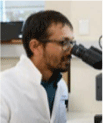A review of inorganic contaminants in Australian marine mammals, birds and turtles
Chad V. Jarolimek A E , Josh J. King A , Simon C. Apte A * , Jane Hall
A * , Jane Hall  B C , Anil Gautam D , Megan Gillmore D and Christopher Doyle D
B C , Anil Gautam D , Megan Gillmore D and Christopher Doyle D
A CSIRO Environment, New Illawarra Road, Menai, NSW 2234, Australia.
B Australian Registry of Wildlife Health, Taronga Conservation Society, Mosman, NSW 2088, Australia.
C Centre for Planetary Health and Food Security, School of Environment and Science, Griffith University, Nathan, Qld 4111, Australia.
D Science, Economics and Insights Division, Department of Planning and Environment, Lidcombe, NSW 2141, Australia.
E Present address: School of Mathematical and Physical Sciences, University of Technology Sydney, Ultimo, NSW 2007, Australia.

Chad Jarolimek is Technical Services Manager at the School of Mathematical and Physical Sciences, University of Technology, Sydney, Australia. His background is in environmental analytical chemistry with a strong focus on the ultratrace analysis of inorganic contaminants in environmental matrices. |

Josh King is a Research Scientist at CSIRO Environment, Lucas Heights, Australia. He has expertise in development and application of analytical methods for challenging environmental matrices. His research interests have focussed on the transport and fate of inorganic contaminants in environmental systems. |

Dr Simon Apte is a Senior Principal Research Scientist at CSIRO Environment, Lucas Heights, Australia. His team specialises in the ultratrace analysis of trace elements in aquatic systems including the low level determination of mercury speciation in waters, sediments and biota. One of his main research activities is assessing the impacts on mining on aquatic systems particularly in the Asia-Pacific region. |

Jane Hall is a PhD student in the Southern Ocean Persistent Organic Pollutants Program based within the Environmental Futures Research Institute at Griffith University, Australia. She is also a wildlife health specialist at the Australian Registry of Wildlife Health at the Taronga Conservation Society Australia. In 2016, she was awarded a Churchill Fellowship to investigate ways to improve Australia's capacity to manage wildlife disease incidents. Her research interests span both terrestrial and aquatic species under the One Health paradigm, and current studies are focused on the health of Australian fur seal species, specifically Arctocephalus forsteri. |

Dr Anil Gautam holds a PhD in Chemistry from Macquarie University in Sydney. He has been working in NSW public service sectors for more than 12 years providing scientific advice to NSW government agencies to help them address chemical pollution issues. His area of expertise includes measuring and monitoring chemicals in the environment, analytical chemistry including laboratory management systems, providing scientific advice regarding chemical pollution incident and environmental data management and visualisation. |

Dr Megan Louise Gillmore is a senior scientist in the Environmental Forensics team at the New South Wales (NSW) Department of Planning and Environment. Megan has a PhD in ecotoxicology and her research has primarily focussed on developing tools for assessing the impact of sediment-bound contaminants on the biological health of aquatic ecosystems. In her current role Megan plays a vital role responding to pollution incidents such as chemical spills and wildlife deaths by providing scientific evidence and technical expertise for the protection of the NSW community and environment. |

Christopher Doyle is an ecotoxicologist with the New South Wales (NSW) Department of Planning and Environment where he leads a team of specialist scientists in providing pollution monitoring and impact assessment services to environmental regulators and incident management teams. Christopher has more than 20 years of experience in assessing the presence of chemical pollutants in the environment and has a particular research interest in the accumulation and effects of contaminants in marine wildlife. |
Environmental Chemistry 20(4) 147-170 https://doi.org/10.1071/EN23057
Submitted: 29 May 2023 Accepted: 11 August 2023 Published: 12 September 2023
© 2023 The Author(s) (or their employer(s)). Published by CSIRO Publishing. This is an open access article distributed under the Creative Commons Attribution 4.0 International License (CC BY)
Environmental context. Metal concentrations can build up to potentially harmful levels in marine mammals as they are at the top of the food chain. This review summarises the information available on metal concentrations in marine mammals, birds and turtles from around Australia. Despite large data gaps, the available data suggest that metal concentrations are similar to those encountered in other regions of the world.
Abstract. A comprehensive compilation of the published data for trace element concentrations (metals and metalloids) in Australian marine mammals, birds and turtles is presented. The majority of studies have relied on the utilisation of opportunistically collected samples, animal strandings and bycatch. This has resulted in large gaps in geographical, temporal and species coverage data. For instance, little or no data are available for cetaceans in New South Wales or the Northern Territory, and out of 14 endemic species of dolphins, data only exist for seven species. The aforementioned data gaps make it hard to identify statistically significant trends, a problem compounded by data being reported in the form of ranges without raw data. Trace element concentrations measured in various marine species and their tissue types are extremely variable, with ranges typically spanning several orders of magnitude, but are generally comparable with international data. Trends in contaminant concentrations with tissue type follow generally accepted patterns of behaviour for higher organisms, with the highest mercury concentrations in liver and cadmium in kidney tissues. Herbivores have lower contaminant loadings than carnivores, reflecting the importance of diet, and there are identifiable age-related trends for elements such as mercury. The lack of supporting pathology on dead and stranded animals and data on specimens from uncontaminated locations restrict conclusions on organism health impacts. There have been some attempts to use non-invasive sampling of indicator tissues such as fur, bristle and feathers. However, it is currently difficult to extrapolate these data to estimate contaminant concentrations in major organs. Recommendations for future investigations are made.
Keywords: bioaccumulation, birds, cadmium, lead, marine fauna, mercury, trace elements, turtles.
References
Agusa T, Takagi K, Kubota R, Anan Y, Iwata H, Tanabe S (2008). Specific accumulation of arsenic compounds in green turtles (Chelonia mydas) and hawksbill turtles (Eretmochelys imbricata) from Ishigaki Island, Japan. Environmental Pollution 153, 127–136.| Specific accumulation of arsenic compounds in green turtles (Chelonia mydas) and hawksbill turtles (Eretmochelys imbricata) from Ishigaki Island, Japan.Crossref | GoogleScholarGoogle Scholar |
Aubail A, Méndez-Fernandez P, Bustamante P, Churlaud C, Ferreira M, Vingada JV, Caurant F (2013). Use of skin and blubber tissues of small cetaceans to assess the trace element content of internal organs. Marine Pollution Bulletin 76, 158–169.
| Use of skin and blubber tissues of small cetaceans to assess the trace element content of internal organs.Crossref | GoogleScholarGoogle Scholar |
Bacher GJ (1985). Mercury concentrations in the australian fur seal Arctocephalus pusillus from SE Australian Waters. Bulletin of Environmental Contamination and Toxicology 35, 490–495.
| Mercury concentrations in the australian fur seal Arctocephalus pusillus from SE Australian Waters.Crossref | GoogleScholarGoogle Scholar |
Baird RW (2009) False killer whale. In ‘Encyclopedia of Marine Mammals’, 2nd edn. (Eds WF Perrin, B Wursig, JGM Thewissen) pp. 405–406. (Academic Press: Burlington, MA, USA)
| Crossref |
Becker PR, Mackey EA, Demiralp R, Schantz MM, Koster BJ, Wise SA (1997). Concentrations of chlorinated hydrocarbons and trace elements in marine mammal tissues archived in the U.S. National Biomonitoring Specimen Bank. Chemosphere 34, 2067–2098.
| Concentrations of chlorinated hydrocarbons and trace elements in marine mammal tissues archived in the U.S. National Biomonitoring Specimen Bank.Crossref | GoogleScholarGoogle Scholar |
Bond AL, Lavers JL (2011). Trace element concentrations in feathers of flesh-footed shearwaters (Puffinus carneipes) from across their breeding range. Archives of Environmental Contamination and Toxicology 61, 318–326.
| Trace element concentrations in feathers of flesh-footed shearwaters (Puffinus carneipes) from across their breeding range.Crossref | GoogleScholarGoogle Scholar |
Bond AL, Hobson KA, Branfireun BA (2015). Rapidly increasing methyl mercury in endangered ivory gull (Pagophila eburnea) feathers over a 130 year record. Proceedings of the Royal Society B: Biological Sciences 282, 20150032
| Rapidly increasing methyl mercury in endangered ivory gull (Pagophila eburnea) feathers over a 130 year record.Crossref | GoogleScholarGoogle Scholar |
Bowles D (1999). An overview of the concentrations and effects of metals in cetacean species. Journal of Cetacean Research and Management 1, 125–148.
| An overview of the concentrations and effects of metals in cetacean species.Crossref | GoogleScholarGoogle Scholar |
Brasso RL, Drummond BE, Borrett SR, Chiaradia A, Polito MJ, Rey AR (2013). Unique pattern of molt leads to low intraindividual variation in feather mercury concentrations in penguins. Environmental Toxicology and Chemistry 32, 2331–2334.
| Unique pattern of molt leads to low intraindividual variation in feather mercury concentrations in penguins.Crossref | GoogleScholarGoogle Scholar |
Braune BM, Gaskin DE (1987). Mercury levels in Bonaparte’s gulls (Larus Philadelphia) during autumn molt in the Quoddy region, New Brunswick, Canada. Archives of Environmental Contamination and Toxicology 16, 539–549.
| Mercury levels in Bonaparte’s gulls (Larus Philadelphia) during autumn molt in the Quoddy region, New Brunswick, Canada.Crossref | GoogleScholarGoogle Scholar |
Brothers N (1991). Albatross mortality and associated bait loss in the Japanese longline fishery in the Southern Ocean. Biological Conservation 55, 255–268.
| Albatross mortality and associated bait loss in the Japanese longline fishery in the Southern Ocean.Crossref | GoogleScholarGoogle Scholar |
Brothers NP, Brown MJ (1987). The potential use of fairy prions (Pachyptila turtur) as monitors of heavy metal levels in Tasmanian waters. Marine Pollution Bulletin 18, 132–134.
| The potential use of fairy prions (Pachyptila turtur) as monitors of heavy metal levels in Tasmanian waters.Crossref | GoogleScholarGoogle Scholar |
Brunborg LA, Graff IE, Frøyland L, Julshamn K (2006). Levels of non-essential elements in muscle from harp seal (Phagophilus groenlandicus) and hooded seal (Cystophora cristata) caught in the Greenland Sea area. Science of the Total Environment 366, 784–798.
| Levels of non-essential elements in muscle from harp seal (Phagophilus groenlandicus) and hooded seal (Cystophora cristata) caught in the Greenland Sea area.Crossref | GoogleScholarGoogle Scholar |
Burger J, Gochfeld M (1991). Lead, mercury, and cadmium in feathers of tropical terns in Puerto Rico and Australia. Archives of Environmental Contamination and Toxicology 21, 311–315.
| Lead, mercury, and cadmium in feathers of tropical terns in Puerto Rico and Australia.Crossref | GoogleScholarGoogle Scholar |
Burger J, Gochfeld M (1995). Biomonitoring of heavy metals in the Pacific basin using avian feathers. Environmental Toxicology and Chemistry 14, 1233–1239.
| Biomonitoring of heavy metals in the Pacific basin using avian feathers.Crossref | GoogleScholarGoogle Scholar |
Burger J, Gochfeld M (1999). Interspecific and locational differences in heavy metal levels in four species of birds near Sydney, Australia. Environmental Monitoring and Assessment 58, 105–119.
| Interspecific and locational differences in heavy metal levels in four species of birds near Sydney, Australia.Crossref | GoogleScholarGoogle Scholar |
Burger J, Gochfeld M (2001) Effects of chemicals and pollution on seabirds. Chapter 15. In ‘Biology of Marine Birds’. (Eds EA Schreiber, J Burger) pp. 485–524 (CRC Press: Boca Raton, FL, USA)
| Crossref |
Burger J, Gochfeld M (2004). Marine birds as sentinels of environmental pollution. EcoHealth 1, 263–274.
| Marine birds as sentinels of environmental pollution.Crossref | GoogleScholarGoogle Scholar |
Butterfield N, Gaylard S (2005) The heavy metal status of South Australian Dolphins. South Australian EPA report. Available at www.epa.sa.gov.au/files/8556_heavy_dolphins.pdf
Cagnazzi D, Broadhurst MK, Reichelt-Brushett A (2019). Metal contamination among endangered, threatened and protected marine vertebrates off south-eastern Australia. Ecological Indicators 107, 105658
| Metal contamination among endangered, threatened and protected marine vertebrates off south-eastern Australia.Crossref | GoogleScholarGoogle Scholar |
Cagnazzi D, Harrison PL, Parra GJ, Reichelt-Brushett A, Marsili L (2020). Geographic and temporal variation in persistent pollutants in Australian humpback and snubfin dolphins. Ecological Indicators 111, 105990
| Geographic and temporal variation in persistent pollutants in Australian humpback and snubfin dolphins.Crossref | GoogleScholarGoogle Scholar |
Canella EG, Kitchener DJ (1992). Differences in mercury levels in female sperm whale. Australian Mammalogy 15, 121–123.
| Differences in mercury levels in female sperm whale.Crossref | GoogleScholarGoogle Scholar |
Carravieri A, Bustamante P, Churlaud C, Cherel Y (2013). Penguins as bioindicators of mercury contamination in the Southern Ocean: birds from the Kerguelen Islands as a case study. Science of the Total Environment 454–455, 141–148.
| Penguins as bioindicators of mercury contamination in the Southern Ocean: birds from the Kerguelen Islands as a case study.Crossref | GoogleScholarGoogle Scholar |
Commonwealth of Australia (2016) Australia New Zealand Food Standards – Schedule 19. Maximum levels of contaminants and natural toxicants. Available at www.foodstandards.gov.au/code/Documents/Sched 19 Contaminant MLs v157.pdf
Cortés-Gómez AA, Romero D, Girondot M (2017). The current situation of inorganic elements in marine turtles: a general review and meta-analysis. Environmental Pollution 229, 567–585.
| The current situation of inorganic elements in marine turtles: a general review and meta-analysis.Crossref | GoogleScholarGoogle Scholar |
Crain DD, Friedlaender AS, Johnston DW, Nowacek DP, Roberts BL, Urian KW, Waples DM, Read AJ (2014). A quantitative analysis of the response of short-finned pilot whales, Globicephala macrorhynchus, to biopsy sampling. Marine Mammal Science 30, 819–826.
| A quantitative analysis of the response of short-finned pilot whales, Globicephala macrorhynchus, to biopsy sampling.Crossref | GoogleScholarGoogle Scholar |
Cuvin-Aralar MLA, Furness RW (1991). Mercury and selenium interaction: a review. Ecotoxicology and Environmental Safety 21, 348–364.
| Mercury and selenium interaction: a review.Crossref | GoogleScholarGoogle Scholar |
Das K, Debacker V, Bouquegneau JM (2000). Metallothioneins in marine mammals. Cellular and Molecular Biology 46, 283–294.
Denton GRW, Breck WG (1981). Mercury in tropical marine organisms from north Queensland. Marine Pollution Bulletin 12, 116–121.
| Mercury in tropical marine organisms from north Queensland.Crossref | GoogleScholarGoogle Scholar |
Denton GRW, Marsh H, Heinsohn GE, Burdon-Jones C (1980). The unusual metal status of the dugong Dugon dugon. Marine Biology 57, 201–219.
| The unusual metal status of the dugong Dugon dugon.Crossref | GoogleScholarGoogle Scholar |
Dietz R, Nørgaard J, Hansen JC (1998). Have Arctic marine mammals adapted to high cadmium levels?. Marine Pollution Bulletin 36, 490–492.
| Have Arctic marine mammals adapted to high cadmium levels?.Crossref | GoogleScholarGoogle Scholar |
Dunlop JN, McNeill S (2017). Local movements, foraging patterns, and heavy metals exposure in Caspian Terns Hydroprogne caspia breeding on Penguin Island, Western Australia. Marine Ornithology 45, 115–120.
Eagles-Smith CA, Ackerman JT, Adelsbach TL, Takekawa JY, Miles AK, Keister RA (2008). Mercury correlations among six tissues for four waterbird species breeding in San Francisco Bay, California, USA. Environmental Toxicology and Chemistry 27, 2136–2153.
| Mercury correlations among six tissues for four waterbird species breeding in San Francisco Bay, California, USA.Crossref | GoogleScholarGoogle Scholar |
El Begearmi MM, Sunde ML, Ganther HE (1977). A mutual protective effect of mercury and selenium in Japanese quail. Poultry Science 56, 313–322.
| A mutual protective effect of mercury and selenium in Japanese quail.Crossref | GoogleScholarGoogle Scholar |
Erftemeijer PLA, Djunarli , Moka W (1993). Stomach content analysis of a dugong (Dugong dugon) from South Sulawesi, Indonesia. Marine and Freshwater Research 44, 229–233.
| Stomach content analysis of a dugong (Dugong dugon) from South Sulawesi, Indonesia.Crossref | GoogleScholarGoogle Scholar |
Ewald JD, Kirk JL, Li M, Sunderland EM (2019). Organ-specific differences in mercury speciation and accumulation across ringed seal (Phoca hispida) life stages. Science of the Total Environment 650, 2013–2020.
| Organ-specific differences in mercury speciation and accumulation across ringed seal (Phoca hispida) life stages.Crossref | GoogleScholarGoogle Scholar |
Fea NI, Harcourt R, Lalas C (1999). Seasonal variation in the diet of New Zealand fur seals (Arctocephalus forsteri) at Otago Peninsula, New Zealand. Wildlife Research 26, 147–160.
| Seasonal variation in the diet of New Zealand fur seals (Arctocephalus forsteri) at Otago Peninsula, New Zealand.Crossref | GoogleScholarGoogle Scholar |
Finger A, Lavers JL, Dann P, Nugegoda D, Orbell JD, Robertson B, Scarpaci C (2015). The Little Penguin (Eudyptula minor) as an indicator of coastal trace metal pollution. Environmental Pollution 205, 365–377.
| The Little Penguin (Eudyptula minor) as an indicator of coastal trace metal pollution.Crossref | GoogleScholarGoogle Scholar |
Finger A, Lavers JL, Orbell JD, Dann P, Nugegoda D, Scarpaci C (2016). Seasonal variation and annual trends of metals and metalloids in the blood of the Little Penguin (Eudyptula minor). Marine Pollution Bulletin 110, 261–273.
| Seasonal variation and annual trends of metals and metalloids in the blood of the Little Penguin (Eudyptula minor).Crossref | GoogleScholarGoogle Scholar |
Finger A, Lavers JL, Dann P, Kowalczyk ND, Scarpaci C, Nugegoda D, Orbell JD (2017). Metals and metalloids in Little Penguin (Eudyptula minor) prey, blood and faeces. Environmental Pollution 223, 567–574.
| Metals and metalloids in Little Penguin (Eudyptula minor) prey, blood and faeces.Crossref | GoogleScholarGoogle Scholar |
Fraga NS, Martins AS, Faust DR, Sakai H, Bianchini A, da Silva CC, Aguirre AA (2018). Cadmium in tissues of green turtles (Chelonia mydas): a global perspective for marine biota. Science of the Total Environment 637–638, 389–397.
| Cadmium in tissues of green turtles (Chelonia mydas): a global perspective for marine biota.Crossref | GoogleScholarGoogle Scholar |
Friberg L, Elinder CG, Kjellstrom T (1992) Environmental health criteria 134 Cadmium. International programme on chemical safety. Available at inchem.org/documents/ehc/ehc/ehc134.htm
Friedman MA, Eaton LR, Carter WH (1978). Protective effects of freeze dried swordfish on methylmercury chloride toxicity in rats. Bulletin of Environmental Contamination and Toxicology 19, 436–443.
| Protective effects of freeze dried swordfish on methylmercury chloride toxicity in rats.Crossref | GoogleScholarGoogle Scholar |
Fujihara J, Kunito T, Kubota R, Tanabe S (2003). Arsenic accumulation in livers of pinnipeds, seabirds and sea turtles: subcellular distribution and interaction between arsenobetaine and glycine betaine. Comparative Biochemistry and Physiology Part C: Toxicology & Pharmacology 136, 287–296.
| Arsenic accumulation in livers of pinnipeds, seabirds and sea turtles: subcellular distribution and interaction between arsenobetaine and glycine betaine.Crossref | GoogleScholarGoogle Scholar |
Ganther HE, Goudie C, Sunde ML, Kopecky MJ, Wagner P, Oh SH, Hoekstra WG (1972). Selenium: relation to decreased toxicity of methylmercury added to diets containing tuna. Science 175, 1122–1124.
| Selenium: relation to decreased toxicity of methylmercury added to diets containing tuna.Crossref | GoogleScholarGoogle Scholar |
Garrigue C, Derville S (2022). Behavioral responses of humpback whales to biopsy sampling on a breeding ground: the influence of age-class, reproductive status, social context, and repeated sampling. Marine Mammal Science 38, 102–117.
| Behavioral responses of humpback whales to biopsy sampling on a breeding ground: the influence of age-class, reproductive status, social context, and repeated sampling.Crossref | GoogleScholarGoogle Scholar |
Gaus C, Grant S, Jin NL, Goot K, Villa A, Neugebauer F, Qi L, Limpus C (2012) Investigation of contaminant levels in green turtles from Gladsone. Entox final report.
| Crossref |
Gerpe MS, De León AP, Bastida R, Moreno VJ, Rodriguez DH (2009). Sharp accumulation of heavy metals after weaning in the South American fur seal Arctocephalus australis. Marine Ecology Progress Series 375, 239–245.
| Sharp accumulation of heavy metals after weaning in the South American fur seal Arctocephalus australis.Crossref | GoogleScholarGoogle Scholar |
Gilmour ME, Holmes ND, Fleishman AB, Kriwoken LK (2019a). Temporal and interspecific variation in feather mercury in four penguin species from Macquarie Island, Australia. Marine Pollution Bulletin 142, 282–289.
| Temporal and interspecific variation in feather mercury in four penguin species from Macquarie Island, Australia.Crossref | GoogleScholarGoogle Scholar |
Gilmour ME, Lavers JL, Lamborg C, Chastel O, Kania SA, Shaffer SA (2019b). Mercury as an indicator of foraging ecology but not the breeding hormone prolactin in seabirds. Ecological Indicators 103, 248–259.
| Mercury as an indicator of foraging ecology but not the breeding hormone prolactin in seabirds.Crossref | GoogleScholarGoogle Scholar |
Gladstone W (1996) Trace metals in sediments, indicator organisms and traditional seafoods of the Torres Strait. Great Barrier Reef Marine Park Authority Report. Available at http://hdl.handle.net/11017/262
Gochfeld M (1980). Tissue distribution of mercury in normal and abnormal young Common Terns. Marine Pollution Bulletin 11, 362–366.
| Tissue distribution of mercury in normal and abnormal young Common Terns.Crossref | GoogleScholarGoogle Scholar |
Guirlet E, Das K (2012). Cadmium toxicokinetics and bioaccumulation in turtles: trophic exposure of Trachemys scripta elegans. Ecotoxicology 21, 18–26.
| Cadmium toxicokinetics and bioaccumulation in turtles: trophic exposure of Trachemys scripta elegans.Crossref | GoogleScholarGoogle Scholar |
Haynes D, Carter S, Gaus C, Müller J, Dennison W (2005). Organochlorine and heavy metal concentrations in blubber and liver tissue collected from Queensland (Australia) dugong (Dugong dugon). Marine Pollution Bulletin 51, 361–369.
| Organochlorine and heavy metal concentrations in blubber and liver tissue collected from Queensland (Australia) dugong (Dugong dugon).Crossref | GoogleScholarGoogle Scholar |
Heinsohn GE, Birch WR (1972). Foods and feeding habits of the dugong, Dugong dugong (erxleben), in Northern Queensland, Australia. Mammalia 36, 414–422.
| Foods and feeding habits of the dugong, Dugong dugong (erxleben), in Northern Queensland, Australia.Crossref | GoogleScholarGoogle Scholar |
Hindell MA, Brothers N, Gales R (1999). Mercury and cadmium concentrations in the tissues of three species of southern albatrosses. Polar Biology 22, 102–108.
| Mercury and cadmium concentrations in the tissues of three species of southern albatrosses.Crossref | GoogleScholarGoogle Scholar |
Honda K, Tatsukawa R, Itano K, Miyazaki N, Fujiyama T (1983). Heavy metal concentrations in muscle, liver and kidney tissue of striped dolphin, Stenella coeruleoalba, and their variations with body length, weight, age and sex. Agricultural and Biological Chemistry 47, 1219–1228.
| Heavy metal concentrations in muscle, liver and kidney tissue of striped dolphin, Stenella coeruleoalba, and their variations with body length, weight, age and sex.Crossref | GoogleScholarGoogle Scholar |
Horne RSC (1985). Diet of royal and rockhopper penguins at Macquarie Island. Emu - Austral Ornithology 85, 150–156.
| Diet of royal and rockhopper penguins at Macquarie Island.Crossref | GoogleScholarGoogle Scholar |
Hume F, Hindell MA, Pemberton D, Gales R (2004). Spatial and temporal variation in the diet of a high trophic level predator, the Australian fur seal (Arctocephalus pusillus doriferus). Marine Biology 144, 407–415.
| Spatial and temporal variation in the diet of a high trophic level predator, the Australian fur seal (Arctocephalus pusillus doriferus).Crossref | GoogleScholarGoogle Scholar |
Ikonomopoulou MP, Olszowy H, Limpus C, Francis R, Whittier J (2011). Trace element concentrations in nesting flatback turtles (Natator depressus) from Curtis Island, Queensland, Australia. Marine Environmental Research 71, 10–16.
| Trace element concentrations in nesting flatback turtles (Natator depressus) from Curtis Island, Queensland, Australia.Crossref | GoogleScholarGoogle Scholar |
Jepson PD, Deaville R, Barber JL, Aguilar À, Borrell A, Murphy S, Barry J, Brownlow A, Barnett J, Berrow S, Cunningham AA, Davison NJ, Ten Doeschate M, Esteban R, Ferreira M, Foote AD, Genov T, Giménez J, Loveridge J, et al. (2016). PCB pollution continues to impact populations of orcas and other dolphins in European waters. Scientific Reports 6, 18573
| PCB pollution continues to impact populations of orcas and other dolphins in European waters.Crossref | GoogleScholarGoogle Scholar |
Julshamn K, Grahl-Nielsen O (2000). Trace element levels in harp seal (Pagophilus groenlandicus) and hooded seal (Cystophora cristata) from the Greenland Sea. A multivariate approach. Science of the Total Environment 250, 123–133.
| Trace element levels in harp seal (Pagophilus groenlandicus) and hooded seal (Cystophora cristata) from the Greenland Sea. A multivariate approach.Crossref | GoogleScholarGoogle Scholar |
Kampalath R, Gardner SC, Méndez-Rodríguez L, Jay JA (2006). Total and methylmercury in three species of sea turtles of Baja California Sur. Marine Pollution Bulletin 52, 1816–1823.
| Total and methylmercury in three species of sea turtles of Baja California Sur.Crossref | GoogleScholarGoogle Scholar |
Kemper C, Gibbs P, Obendorf D, Marvanek S, Lenghaus C (1994). A review of heavy metal and organochlorine levels in marine mammals in Australia. Science of the Total Environment 154, 129–139.
| A review of heavy metal and organochlorine levels in marine mammals in Australia.Crossref | GoogleScholarGoogle Scholar |
Koeman JH, Peeters WHM, Koudstaal-Hol CHM, Tjioe PS, De Goeij JJM (1973). Mercury-selenium correlations in marine mammals. Nature 245, 385–386.
| Mercury-selenium correlations in marine mammals.Crossref | GoogleScholarGoogle Scholar |
Komoroske LM, Lewison RL, Seminoff JA, Deheyn DD, Dutton PH (2011). Pollutants and the health of green sea turtles resident to an urbanized estuary in San Diego, CA. Chemosphere 84, 544–552.
| Pollutants and the health of green sea turtles resident to an urbanized estuary in San Diego, CA.Crossref | GoogleScholarGoogle Scholar |
Kuenstl L, Griesel S, Prange A, Goessler W (2009). Arsenic speciation in bodily fluids of harbor seals (Phoca vitulina) and harbor porpoises (Phocoena phocoena). Environmental Chemistry 6, 319–327.
| Arsenic speciation in bodily fluids of harbor seals (Phoca vitulina) and harbor porpoises (Phocoena phocoena).Crossref | GoogleScholarGoogle Scholar |
Labrada-Martagón V, Tenorio Rodríguez PA, Méndez-Rodríguez LC, Zenteno-Savín T (2011). Oxidative stress indicators and chemical contaminants in East Pacific green turtles (Chelonia mydas) inhabiting two foraging coastal lagoons in the Baja California peninsula. Comparative Biochemistry and Physiology Part C: Toxicology & Pharmacology 154, 65–75.
| Oxidative stress indicators and chemical contaminants in East Pacific green turtles (Chelonia mydas) inhabiting two foraging coastal lagoons in the Baja California peninsula.Crossref | GoogleScholarGoogle Scholar |
Lavers JL, Bond AL (2013). Contaminants in indigenous harvests of apex predators: the Tasmanian Short-tailed Shearwater as a case study. Ecotoxicology and Environmental Safety 95, 78–82.
| Contaminants in indigenous harvests of apex predators: the Tasmanian Short-tailed Shearwater as a case study.Crossref | GoogleScholarGoogle Scholar |
Lavers JL, Bond AL, Hutton I (2014). Plastic ingestion by Flesh-footed Shearwaters (Puffinus carneipes): implications for fledgling body condition and the accumulation of plastic-derived chemicals. Environmental Pollution 187, 124–129.
| Plastic ingestion by Flesh-footed Shearwaters (Puffinus carneipes): implications for fledgling body condition and the accumulation of plastic-derived chemicals.Crossref | GoogleScholarGoogle Scholar |
Lavery TJ, Butterfield N, Kemper CM, Reid RJ, Sanderson K (2008). Metals and selenium in the liver and bone of three dolphin species from South Australia, 1988–2004. Science of the Total Environment 390, 77–85.
| Metals and selenium in the liver and bone of three dolphin species from South Australia, 1988–2004.Crossref | GoogleScholarGoogle Scholar |
Law RJ, Fileman CF, Hopkins AD, Baker JR, Harwood J, Jackson DB, Kennedy S, Martin AR, Morris RJ (1991). Concentrations of trace metals in the livers of marine mammals (seals, porpoises and dolphins) from waters around the British Isles. Marine Pollution Bulletin 22, 183–191.
| Concentrations of trace metals in the livers of marine mammals (seals, porpoises and dolphins) from waters around the British Isles.Crossref | GoogleScholarGoogle Scholar |
Law RJ, Morris RJ, Allchin CR, Jones BR, Nicholson MD (2003). Metals and organochlorines in small cetaceans stranded on the east coast of Australia. Marine Pollution Bulletin 46, 1206–1211.
| Metals and organochlorines in small cetaceans stranded on the east coast of Australia.Crossref | GoogleScholarGoogle Scholar |
Lischka A, Betty EL, Braid HE, Pook CJ, Gaw S, Bolstad KSR (2021). Trace element concentrations, including Cd and Hg, in long-finned pilot whales (Globicephala melas edwardii) mass stranded on the New Zealand coast. Marine Pollution Bulletin 165, 112084
| Trace element concentrations, including Cd and Hg, in long-finned pilot whales (Globicephala melas edwardii) mass stranded on the New Zealand coast.Crossref | GoogleScholarGoogle Scholar |
Littnan CL, Arnould JPY, Harcourt R (2007). Effect of proximity to the shelf edge on the diet of female Australian fur seals. Marine Ecology Progress Series 338, 257–267.
| Effect of proximity to the shelf edge on the diet of female Australian fur seals.Crossref | GoogleScholarGoogle Scholar |
Lock JW, Thompson DR, Furness RW, Bartle JA (1992). Metal concentrations in seabirds of the New Zealand region. Environmental Pollution 75, 289–300.
| Metal concentrations in seabirds of the New Zealand region.Crossref | GoogleScholarGoogle Scholar |
Long M, Reid RJ, Kemper CM (1998). Cadmium accumulation and toxicity in the bottlenose dolphin Tursiops truncatus, the common dolphin Delphinus delphis, and some dolphin prey species in South Australia. Australian Mammalogy 20, 25–33.
| Cadmium accumulation and toxicity in the bottlenose dolphin Tursiops truncatus, the common dolphin Delphinus delphis, and some dolphin prey species in South Australia.Crossref | GoogleScholarGoogle Scholar |
López-Berenguer G, Peñalver J, Martínez-López E (2020). A critical review about neurotoxic effects in marine mammals of mercury and other trace elements. Chemosphere 246, 125688
| A critical review about neurotoxic effects in marine mammals of mercury and other trace elements.Crossref | GoogleScholarGoogle Scholar |
Luoma SN, Rainbow PS (2008) ‘Metal contamination in aquatic environments: science and lateral management.’ (Cambridge University Press: Cambridge, UK). Available at www.cabdirect.org/cabdirect/abstract/20083330272
Lynch M, Kirkwood R, Gray R, Robson D, Burton G, Jones L, Sinclair R, Arnould JPY (2012). Characterization and causal investigations of an alopecia syndrome in Australian fur seals (Arctocephalus pusillus doriferus). Journal of Mammalogy 93, 504–513.
| Characterization and causal investigations of an alopecia syndrome in Australian fur seals (Arctocephalus pusillus doriferus).Crossref | GoogleScholarGoogle Scholar |
Manning T, Ross GA, Symons R (2008). Environmental contaminants in white-bellied sea eagles (Halialeetus leucogaster) found in Sydney, Australia. Australiasian Journal of Ecotoxicology 14, 21–30.
| Environmental contaminants in white-bellied sea eagles (Halialeetus leucogaster) found in Sydney, Australia.Crossref | GoogleScholarGoogle Scholar |
Marcovecchio JE, Gerpe MS, Moreno VJ, Bastida RO, Rodriguez DH (1991) Organ tissue distribution of total mercury in South American Fur Seal, Arctocephalus australis. In ‘Heavy Metals in the Environment Proceedings of the 8th International Conference’, Edinburgh, UK. Available at http://hdl.handle.net/1834/26696
Marsh HE (1989). Mass Stranding of Dugongs by a tropical cyclone in Northern Australia. Marine Mammal Science 5, 78–84.
| Mass Stranding of Dugongs by a tropical cyclone in Northern Australia.Crossref | GoogleScholarGoogle Scholar |
Mazzaro LM, Dunn St JL, St. Aubin DJ, Andrews GA, Chavey PS (2004). Serum indices of body stores of iron in northern fur seals (Callorhinus ursinus) and their relationship to hemochromatosis. Zoo Biology 23, 205–218.
| Serum indices of body stores of iron in northern fur seals (Callorhinus ursinus) and their relationship to hemochromatosis.Crossref | GoogleScholarGoogle Scholar |
McIntyre AD, Kinne O (1979). Marine Ecology. The Journal of Animal Ecology 48, 332–333.
| Marine Ecology.Crossref | GoogleScholarGoogle Scholar |
McManus TJ, Wapstra JE, Guiler ER, Munday BL, Obendorf DL (1984). Cetacean strandings in Tasmania from February 1978 to May 1983. Papers and Proceedings of the Royal Society of Tasmania 118, 117–135.
| Cetacean strandings in Tasmania from February 1978 to May 1983.Crossref | GoogleScholarGoogle Scholar |
Monk A, Charlton-Robb K, Buddhadasa S, Thompson RM (2014). Comparison of mercury contamination in live and dead dolphins from a newly described species, Tursiops australis. PLoS One 9, e104887
| Comparison of mercury contamination in live and dead dolphins from a newly described species, Tursiops australis.Crossref | GoogleScholarGoogle Scholar |
Moser R, Zaccarini F, Alber T, Kerbl R (2020). First finding of tiemannite, HgSe, in human bladder stones: an electron microprobe study. Micron 138, 102928
| First finding of tiemannite, HgSe, in human bladder stones: an electron microprobe study.Crossref | GoogleScholarGoogle Scholar |
Munday BL (1985). Mercury levels in the musculature of stranded whales in Tasmania. Tasmanian Fisheries Research 27, 11–13.
Nakazawa E, Ikemoto T, Hokura A, Terada Y, Kunito T, Tanabe S, Nakai I (2011). The presence of mercury selenide in various tissues of the striped dolphin: Evidence from μ-XRF-XRD and XAFS analyses. Metallomics 3, 719–725.
| The presence of mercury selenide in various tissues of the striped dolphin: Evidence from μ-XRF-XRD and XAFS analyses.Crossref | GoogleScholarGoogle Scholar |
NOAA (2022) National marine mammal tissue bank. Available at www.fisheries.noaa.gov/national/marine-mammal-protection/national-marine-mammal-tissue-bank
Noren DP, Mocklin JA (2012). Review of cetacean biopsy techniques: factors contributing to successful sample collection and physiological and behavioral impacts. Marine Mammal Science 28, 154–199.
| Review of cetacean biopsy techniques: factors contributing to successful sample collection and physiological and behavioral impacts.Crossref | GoogleScholarGoogle Scholar |
O’Shea TJ, Moore JF, Kochman HI (1984). Contaminant concentrations in Manatees in Florida. The Journal of Wildlife Management 48, 741–748.
| Contaminant concentrations in Manatees in Florida.Crossref | GoogleScholarGoogle Scholar |
Peterson SA, Ralston NVC, Peck DV, Sickle JV, Robertson JD, Spate VL, Morris JS (2009). How might selenium moderate the toxic effects of mercury in stream fish of the Western U.S.?. Environmental Science & Technology 43, 3919–3925.
| How might selenium moderate the toxic effects of mercury in stream fish of the Western U.S.?.Crossref | GoogleScholarGoogle Scholar |
Pople AR, Gordon AN, Ng J (1998). Trace metal concentrations in livers and kidneys of sea turtles from south-eastern Queensland, Australia. Marine and Freshwater Research 49, 409–414.
| Trace metal concentrations in livers and kidneys of sea turtles from south-eastern Queensland, Australia.Crossref | GoogleScholarGoogle Scholar |
Puget Sound water Quality Authority (1994) Recommended guidelines for sampling marine mamal tissue for chemical analysis in Puget Sound. Available at https://www.cascadiaresearch.org/files/sampling.pdf
Puskic PS, Lavers JL, Adams LR, Bond AL (2020). Ingested plastic and trace element concentrations in Short-tailed Shearwaters (Ardenna tenuirostris). Marine Pollution Bulletin 155, 111143
| Ingested plastic and trace element concentrations in Short-tailed Shearwaters (Ardenna tenuirostris).Crossref | GoogleScholarGoogle Scholar |
Rainbow PS (Ed.) (2018) Coastal seas and oceans. In ‘Trace Metals in the Environment and Living Organisms: The British Isles as a Case Study’. (Ed. PS Rainbow) pp. 565–654. (Cambridge University Press: Cambridge, UK)
| Crossref |
Ralston NVC, Ralston CR, Blackwell III JL, Raymond LJ (2008). Dietary and tissue selenium in relation to methylmercury toxicity. NeuroToxicology 29, 802–811.
| Dietary and tissue selenium in relation to methylmercury toxicity.Crossref | GoogleScholarGoogle Scholar |
Riget F, Muir D, Kwan M, Savinova T, Nyman M, Woshner V, O’Hara T (2005). Circumpolar pattern of mercury and cadmium in ringed seals. Science of the Total Environment 351–352, 312–322.
| Circumpolar pattern of mercury and cadmium in ringed seals.Crossref | GoogleScholarGoogle Scholar |
Rosen DAS, Worthy G (2018) Nutrition and energetics. In ‘CRC Handbook of Marine Mammal Medicine’, 3rd edn. (Eds FMD Gulland, LA Dierauf, KL Whitman) pp. 791–827. (CRC Press: Boca Raton, FL, USA)
| Crossref |
SA EPA (2000) Monitoring Report: heavy metals and PCBs in dolphins, sediment and fish. South Australian Environmental Protection agency report. Available at http://www.epa.sa.gov.au/files/477410_dolphin.pdf
Savery LC, Evers DC, Wise SS, Falank C, Wise J, Gianios C, Kerr I, Payne R, Thompson WD, Perkins C, Zheng T, Zhu C, Benedict L, Wise JP (2013). Global mercury and selenium concentrations in skin from free-ranging sperm whales (Physeter macrocephalus). Science of the Total Environment 450–451, 59–71.
| Global mercury and selenium concentrations in skin from free-ranging sperm whales (Physeter macrocephalus).Crossref | GoogleScholarGoogle Scholar |
Savery LC, Wise SS, Falank C, Wise J, Gianios C, Douglas Thompson W, Perkins C, Zheng T, Zhu C, Wise JP (2014). Global assessment of oceanic lead pollution using sperm whales (Physeter macrocephalus) as an indicator species. Marine Pollution Bulletin 79, 236–244.
| Global assessment of oceanic lead pollution using sperm whales (Physeter macrocephalus) as an indicator species.Crossref | GoogleScholarGoogle Scholar |
Stavros HCW, Bossart GD, Hulsey TC, Fair PA (2008). Trace element concentrations in blood of free-ranging bottlenose dolphins (Tursiops truncatus): Influence of age, sex and location. Marine Pollution Bulletin 56, 371–379.
| Trace element concentrations in blood of free-ranging bottlenose dolphins (Tursiops truncatus): Influence of age, sex and location.Crossref | GoogleScholarGoogle Scholar |
Stavros HCW, Stolen M, Durden WN, McFee W, Bossart GD, Fair PA (2011). Correlation and toxicological inference of trace elements in tissues from stranded and free-ranging bottlenose dolphins (Tursiops truncatus). Chemosphere 82, 1649–1661.
| Correlation and toxicological inference of trace elements in tissues from stranded and free-ranging bottlenose dolphins (Tursiops truncatus).Crossref | GoogleScholarGoogle Scholar |
Stockin KA, Law RJ, Duignan PJ, Jones GW, Porter L, Mirimin L, Meynier L, Orams MB (2007). ) Trace elements, PCBs and organochlorine pesticides in New Zealand common dolphins (Delphinus sp.). Science of the Total Environment 387, 333–345.
| ) Trace elements, PCBs and organochlorine pesticides in New Zealand common dolphins (Delphinus sp.).Crossref | GoogleScholarGoogle Scholar |
Sun X, Yu RQ, Zhang M, Zhang X, Chen X, Xiao Y, Ding Y, Wu Y (2017). Correlation of trace element concentrations between epidermis and internal organ tissues in Indo-Pacific humpback dolphins (Sousa chinensis). Science of the Total Environment 605–606, 238–245.
| Correlation of trace element concentrations between epidermis and internal organ tissues in Indo-Pacific humpback dolphins (Sousa chinensis).Crossref | GoogleScholarGoogle Scholar |
Teigen SW, Andersen RA, Daae HL, Skaare JU (1999). Heavy metal content in liver and kidneys of grey seals (Halichoerus grypus) in various life stages correlated with metallothionein levels: some metal—binding characteristics of this protein. Environmental Toxicology and Chemistry 18, 2364–2369.
| Heavy metal content in liver and kidneys of grey seals (Halichoerus grypus) in various life stages correlated with metallothionein levels: some metal—binding characteristics of this protein.Crossref | GoogleScholarGoogle Scholar |
Thomas CR, Bennett WW, Garcia C, Simmonds A, Honchin C, Turner R, Madden Hof CA, Bell I (2020). Coastal bays and coral cays: multi-element study of Chelonia mydas forage in the Great Barrier Reef (2015–2017). Science of the Total Environment 740, 140042
| Coastal bays and coral cays: multi-element study of Chelonia mydas forage in the Great Barrier Reef (2015–2017).Crossref | GoogleScholarGoogle Scholar |
Thompson DR (1990) Metal levels in marine vertebrates. In ‘Heavy Metals in the Marine Environment’. (Eds RW Furness, PS Rainbow) pp. 143–203. (CRC Press: Boca Raton, FL, USA)
UN Environment (2019) ‘Global Mercury Assessment 2018.’ (UN Environment Programme, Chemicals and Health Branch: Geneva, Switzerland) Available at https://www.unep.org/resources/publication/global-mercury-assessment-2018?_ga=2.44504609.409835767.1671522531-1889810577.1671235716
UNEP (2010) ‘Ridding the World of POPs: A Guide to the Stockholm Convention.’ (United Nations Environmental Program: Geneva, Switzerland) Available at https://digitallibrary.un.org/record/752644?ln=en
van de Merwe JP, Hodge M, Olszowy HA, Whittier JM, Lee SY (2010). Using blood samples to estimate persistent organic pollutants and metals in green sea turtles (Chelonia mydas). Marine Pollution Bulletin 60, 579–588.
| Using blood samples to estimate persistent organic pollutants and metals in green sea turtles (Chelonia mydas).Crossref | GoogleScholarGoogle Scholar |
Villa CA, Flint M, Bell I, Hof C, Limpus CJ, Gaus C (2017). Trace element reference intervals in the blood of healthy green sea turtles to evaluate exposure of coastal populations. Environmental Pollution 220, 1465–1476.
| Trace element reference intervals in the blood of healthy green sea turtles to evaluate exposure of coastal populations.Crossref | GoogleScholarGoogle Scholar |
Villa CA, Bell I, Madden Hof C, Limpus CJ, Gaus C (2019). Elucidating temporal trends in trace element exposure of green turtles (Chelonia mydas) using the toxicokinetic differences of blood and scute samples. Science of the Total Environment 651, 2450–2459.
| Elucidating temporal trends in trace element exposure of green turtles (Chelonia mydas) using the toxicokinetic differences of blood and scute samples.Crossref | GoogleScholarGoogle Scholar |
Wagemann R, Muir DCG (1984) Concentrations of heavy metals and organochlorines in marine mammals of northern waters: overview and evaluation. Canadian Technical Report of Fisheries and Aquatic Sciences No. 1279. Available at http://pubs.aina.ucalgary.ca/misc/14594.pdf
Wagemann R, Trebacz E, Boila G, Lockhart WL (1998). Methylmercury and total mercury in tissues of arctic marine mammals. Science of the Total Environment 218, 19–31.
| Methylmercury and total mercury in tissues of arctic marine mammals.Crossref | GoogleScholarGoogle Scholar |
Wagemann R, Trebacz E, Boila G, Lockhart WL (2000). Mercury species in the liver of ringed seals. Science of the Total Environment 261, 21–32.
| Mercury species in the liver of ringed seals.Crossref | GoogleScholarGoogle Scholar |
Waterhouse J, Apte SC, Petus C, Angel BM, Wolanski E, Bainbridge S, Tracey D, Jarolimek CV, King J, Mellors J, Brodie J (2021) Assessing the influence of the Fly River discharge on the Torres Strait. Report to the National Environmental Science Program. Available at nesptropical.edu.au/wp-content/uploads/2021/06/NESP-TWQ-Project-5.14-Final-Report_COMPLETE.pdf
Weijs L, Vijayasarathy S, Villa CA, Neugebauer F, Meager JJ, Gaus C (2016). Screening of organic and metal contaminants in Australian humpback dolphins (Sousa sahulensis) inhabiting an urbanised embayment. Chemosphere 151, 253–262.
| Screening of organic and metal contaminants in Australian humpback dolphins (Sousa sahulensis) inhabiting an urbanised embayment.Crossref | GoogleScholarGoogle Scholar |
Woolford L, Franklin C, Whap T, Loban F, Lanyon JM (2015). Pathological findings in wild harvested dugongs Dugong dugon of central Torres Strait, Australia. Diseases of Aquatic Organisms 113, 89–102.
| Pathological findings in wild harvested dugongs Dugong dugon of central Torres Strait, Australia.Crossref | GoogleScholarGoogle Scholar |
Woshner V, Knott K, Wells R, Willetto C, Swor R, O’Hara T (2008). Mercury and selenium in blood and epidermis of bottlenose dolphins (Tursiops truncatus) from Sarasota Bay, FL: interaction and relevance to life history and hematologic parameters. EcoHealth 5, 360–370.
| Mercury and selenium in blood and epidermis of bottlenose dolphins (Tursiops truncatus) from Sarasota Bay, FL: interaction and relevance to life history and hematologic parameters.Crossref | GoogleScholarGoogle Scholar |


